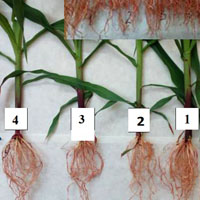Application of Zn-containing foliar fertilisers for recovery of the grain productivity potential of Zn-deficient maize plants

Accepted: 5 February 2021
PDF: 583
All claims expressed in this article are solely those of the authors and do not necessarily represent those of their affiliated organizations, or those of the publisher, the editors and the reviewers. Any product that may be evaluated in this article or claim that may be made by its manufacturer is not guaranteed or endorsed by the publisher.
Maize is one of the most sensitive industrial crops of zinc supply. Questions about fertilisation methods and the type of fertilisers used are the subject of serious scientific discussion. The key objective of this paper was to evaluate the possibilities to recover the yielding potential of Zn-deficient young maize plants by application of nanosized Zn-containing foliar fertilisers. The agronomic response of Zn-deficient maize plants to foliar fertilisation with nanoscale zinc-containing foliar fertilisers was investigated. The study was conducted in two stages: i) planting and growing the plants under controlled conditions in a zinc-deficient environment for three months; and ii) moving the plants and continuing the experiment in field conditions. A single spray with two nanosized zinc-containing foliar fertilisers was carried out. The physiological status of the plants and the dynamic of zinc and micro- and macroelements concentration in plant organs were monitored. The influence of foliar zinc fertilisation on yield and grain structural components has been determined. Our results indicated that zinc fertilisation throughout the initial growth stages plays a decisive role in the formation of the reproductive organs of maize plants. Foliar zinc fertilisers can entirely recover the physiological performance of plants grown under conditions of zinc deficiency.
Highlights
- The application of foliar fertilisers is extremely suitable as the possibility of much faster zinc absorption than from the soil.
- Zn-fertilisation of maize plants during the initial growth stages plays a decisive role in the formation of the reproductive organs of maize.
- Foliar zinc fertilisers can entirely recover the physiological performance of plants grown under conditions of zinc deficiency.
How to Cite

This work is licensed under a Creative Commons Attribution-NonCommercial 4.0 International License.
PAGEPress has chosen to apply the Creative Commons Attribution NonCommercial 4.0 International License (CC BY-NC 4.0) to all manuscripts to be published.

 https://doi.org/10.4081/ija.2021.1759
https://doi.org/10.4081/ija.2021.1759







